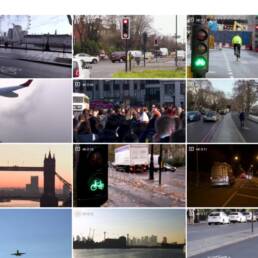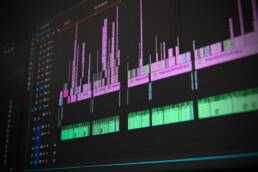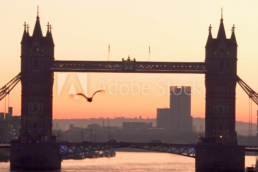
It all started in a living room with a dodgy telly.
I was round my parents’ house. They had gone to deal with the TV signal, and I stayed behind to see if the picture would drop out again. That was when it happened. A Green Party advert popped up. A few seconds in, something about one of the shots felt incredibly familiar. Too familiar.
I knew the location straight away. Westminster, near the cycleway. And the framing? That was mine. That was how I shoot.
But before I got carried away, I had to be sure.
Table of Contents
ToggleThe Triple Check
The shot lasted just a few seconds, with bold text over the top obscuring most of the detail. Still, something about the composition and movement told me it was one of mine. I remembered how I had lined it up to tell a story visually, focusing on the cycle symbol and the movement of bikes over it. No faces, no distractions, just a clean message.
I found the advert online, rewatched it, then pulled up my Shutterstock portfolio. I located the original file and overlaid it for comparison. Even with the text in the way, it was a perfect match. The movement, the timing, the way the frame resolved, it was all there.
That was my shot. No doubt.
Shot with Purpose
This was not a lucky accident. I had filmed that clip with intent.
It was an early morning shoot timed around 6.30am to catch the pre-rush-hour flow. Busy enough to show life, but not so packed that I would need to blur faces or chase release forms. I used my Canon C200, shooting in 4K ProRes 422HQ. That gave me plenty of quality for future proofing, and Shutterstock’s platform allows buyers to downscale to MP4 if they prefer.
The shot focused on the cycle lane iconography and the bikes moving through. No visible branding. No one identifiable. Just a story in motion.
That is the goal with stock footage. You want evergreen content. Something useful year after year without needing context or explanation. Keep out anything that might date it. No Christmas jumpers. No World Cup flags. No seasonal distractions.
From Upload to Airtime
Once edited and graded, I trimmed the shot to under 30 seconds, tagged it, and uploaded it to Shutterstock using FTP. It sat in the library for a while.
From what I can tell, the clip was downloaded, then spent about six months in post production before it finally aired. That kind of delay is not unusual in political or brand messaging. Sign off can take months especially with multiple stakeholders, legal checks and campaign teams all weighing in.
When it finally hit the screen, my payment came through.
Fifteen dollars.
Not exactly enough to retire on. But for me, the real value was seeing that clip used as intended. It landed exactly where I hoped it might, in a broadcast telling a story about sustainable travel and urban planning.
Ill do a guide in how to edit and grade for stock, until then check out my editing services to help if you need anything

Why Shutterstock Works for TV
Editorial teams work to brutal deadlines. If they need a clip of cyclists in Westminster, they are not going to send a crew across London or across the world to get it. They go to Shutterstock. It is faster, cheaper, and the licensing is clear.
It also gives them certainty. A buyer in New York knows they are paying a fixed fee for footage that is already cleared, already searchable, and already ready to drop into a timeline.
That is the value of stock.
Lessons from a Four Second Clip
Stock is not just about pretty visuals. It is about story. A good stock clip communicates something instantly.
Here is what matters:
- Think in iconography. Double decker buses, cycle lane symbols, red post boxes. These are visual shortcuts to meaning.
- Motion still matters. AI can not yet replicate real world movement convincingly. If it moves, it still has value.
- Frame with flexibility. Leave space for titles and overlays. Your footage might not be used full screen.
- Quality counts. Shoot at high resolution. Grade it cleanly. Aim for broadcast ready results.
What It Pays and Why I Keep Doing It
The money is not great. Most clips earn a few pounds here and there. Occasionally something lands bigger, like a rainy Oxford Street bus shot that earned me nearly eighty pounds. Or a pan of a bus crossing in front of St Paul’s Cathedral, which brought in a few hundred over time.
Still, I have covered my gear costs. The camera paid for itself in about a year. And what started as a side project while working at Transport for London turned into something worthwhile.
Tips for New Contributors
If you want to build a solid portfolio:
- Shoot recognisable locations.
- Avoid people where possible.
- Keyword accurately.
- Upload widely.
More shops means more chances to sell. I do not rely on stock for income, so I spread my work across multiple platforms. If it were my only job, I might be more exclusive. But for now, volume and reach work in my favour.
If you need any help with anything, drop me a line
Final Thoughts
The secret to getting on national TV was not a lucky break. It was planning, consistency and thinking like an editor.
I knew what story I wanted to tell. I filmed it cleanly. I uploaded it with the right tags. And eventually someone needed it.
Being self employed, we have to adapt or die. Stock is one of those things that won’t make you rich overnight, but it keeps the skills sharp and the opportunities coming.
Joe Savitch-Lee
Over 20 years in media, having worked on four continents and on countless projects both on location and in a suite. He has excelled in both building/maintaining editing systems and editing them.
Related Posts
January 10, 2025
101 Questions Every Video Editor Had to Ask
The ultimate 101 Video Editing FAQ your all-in-one guide to mastering the art…




